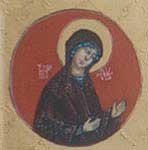
![]()

co mage}
mage}
September 1 - December 1, 2001
About Icons
Rules for the Iconographer
origin unknown
1. Before starting work, make the sign of the Cross; pray in silence, & pardon your enemies.
2. Work with care on every detail of your ikon, as if you were working in front of the Lord Himself.
3. During work, pray in order to strengthen yourself physically and spiritually; avoid above all useless words, and keep silence.
4. Pray in particular to the Saint whose face you are painting. Keep your mind from distractions, and the Saint will be with you.
5. When you have to choose a color, stretch your hands interiorly to the Lord and ask His council.
6. Do not be jealous of your neighbor's work: his success is your success, too.
7. When your ikon is finished, thank God that His Mercy granted you the grace to paint the Holy Images.
8. Have your ikon blessed by putting it on the altar. Be the first to pray before it, before giving it to others.
9. Never forget: the joy of spreading ikons in the world. The joy of work in ikon-painting. The joy of giving the Saint the possibility to shine through his ikon. The joy of being in union with the Saint whose face you are painting.
The Art of the Icon
To start with, if the icon is a work of art, it is not one which is similar in kind to other works of art. It is not even a work of religious art, as we have come to use the term. What we tend to call a work of religious art is a work with a religious theme. If it is of the Christian tradition that we are speaking, then a work of religious art is a work which presents to our view scenes drawn from the scriptures or from the lives of the saints or from some other recognized source. Because an icon also presents such a subject, we classify it too as religious, as we do a picture of the holy family by Raphael or of the Crucifixion by Matisse. In so doing we forget that what determines the nature of a work of art is not so much its subject as its form; and that while a work of art may be called religious because its subject is drawn from the storehouse of scriptural text or sacred legend, it cannot be called an icon unless its form derives from spiritual vision, spiritual understanding, and is fused (though not confused) with this spiritual content. In other words the icon is, as we said, a work of sacred art – the major, if not the sole, pictorial form of sacred art in the Christian tradition.
Philip Sherrard, The Sacred in Life and Art, Golgonooza Press, 1990: 71.
In our present planetary state of apparent chaos, temporal density and speed, the icon presents a very strong and pure visual statement of order which is stabilizing to look at. Although most observers might not appreciate the intricate formal order underlying the image, there is a sense of a higher order which opens a door or window to a world of beauty, truth, goodness or Godliness that is mysteriously comforting and which approaches holiness. Icons present timeless states of the sacred which we all yearn for and can momentarily visit while in their presence.
Robert Armon, Iconographer
The icon is God's silent, boundless mercy. The icon is God's poem and song without words. The icon is God's touch, a kiss, and then the empty place that calls forever after to us – the icon is the echo of God's incarnatation once and for all time upon the earth. The icon is a rest stop on the way home, a small sanctuary, a protection, a moveable feast that makes us tremble. Blessed be the Name and Form of the Holy One. Blessed be all that God has made. Glory, glory, glory in it. Amen.
Megan McKenna in the foreword to The Bride by William Hart McNichols and Daniel Berrigan